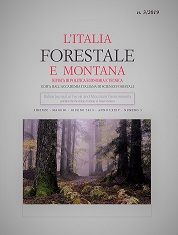Control activity by State Forestry Corps / Carabinieri Forestry on forest fellings in Florence province during 2009-2017 period. State of the art: evolution or involution?
Published 2019-09-26
Keywords
- forest utilizations,
- forest controls,
- work supervision
Copyright (c) 2019 Italian Journal of Forest and Mountain Environments

This work is licensed under a Creative Commons Attribution-NonCommercial 4.0 International License.
Abstract
For the period between 2009 and 2016 the former State Forestry Corps (C.F.S. Corpo Forestale dello Stato) and after 1st January 2017 the Carabinieri Forestry Corp had made a comprehensive analysis regarding police checks carried out within Florence province, about forms concerning declarations and authorizations for forest fellings under the 39/2000 Tuscany Regional Law and subsequent implementing Regulations. In order to inform further legal and regulatory developments on this subject, the most commonly found regulation violations were listed and discussed with particular concern about the impact to forest conservation and safeguarding of the territory. The always increasing complexity in implementing this type of controls was highlighted, and knowledge of the territory, technical skills and competence of the operator remained the essential features of approach to the single cases. Controls mainly concerned (i) verification of technical-cultural aspects using suitable technological equipment and (ii) compliance of legality in workforce employment and safety in workplace, defined by Italian Legislative Decree No. 81/2008 and subsequent amendments and addenda.To contrast the increasingly widespread phenomenon of rule violations, survey should be tackled through repression actions - with joint controls among Police, Local Health Authority (ASL) and Labor Inspectorate etc. - and prevention activities - fostering cooperation with Trade Associations; while introduction of rules aimed to limit or even to cancel out the phenomenon would be recommended (e.g., introducing a qualification card for chainsaw use and extending the Register to Forest Companies). Moreover, the here-presented analysis suggested the introduction of a new professional figure: the forest worksite director, devoted to pay attention to worksite organization, especially for all those aspects related to worker safety.

